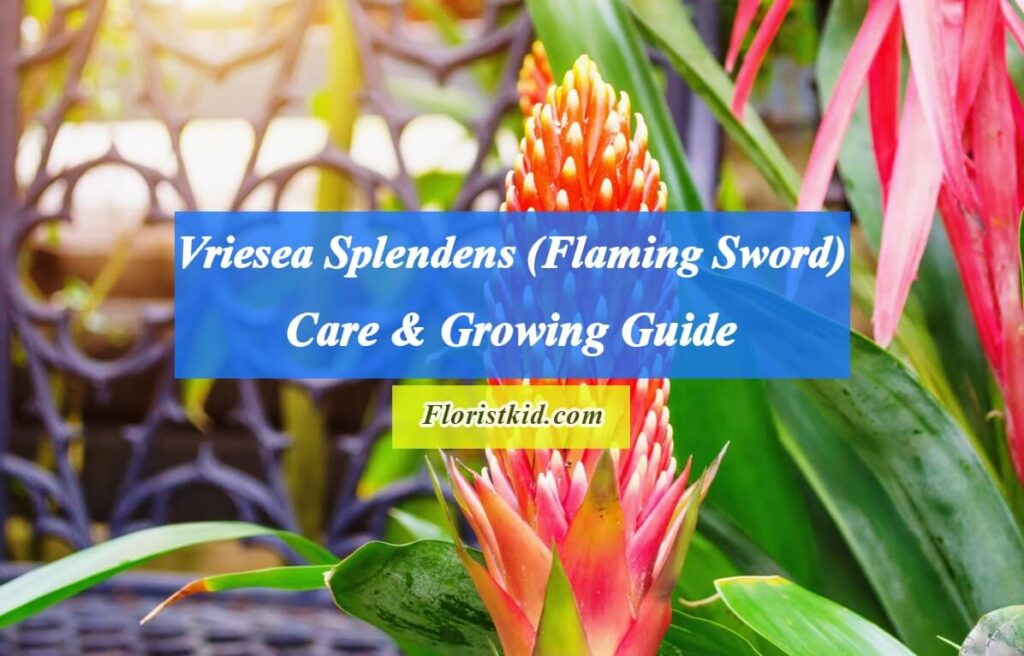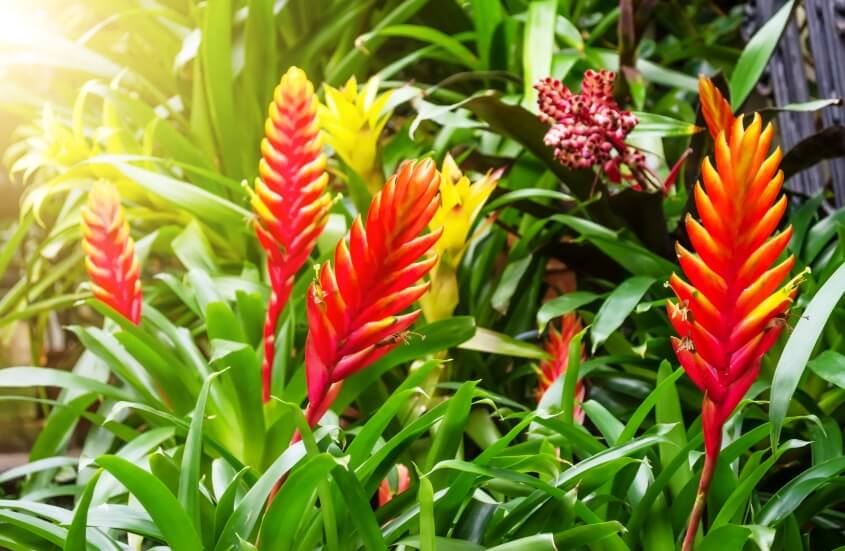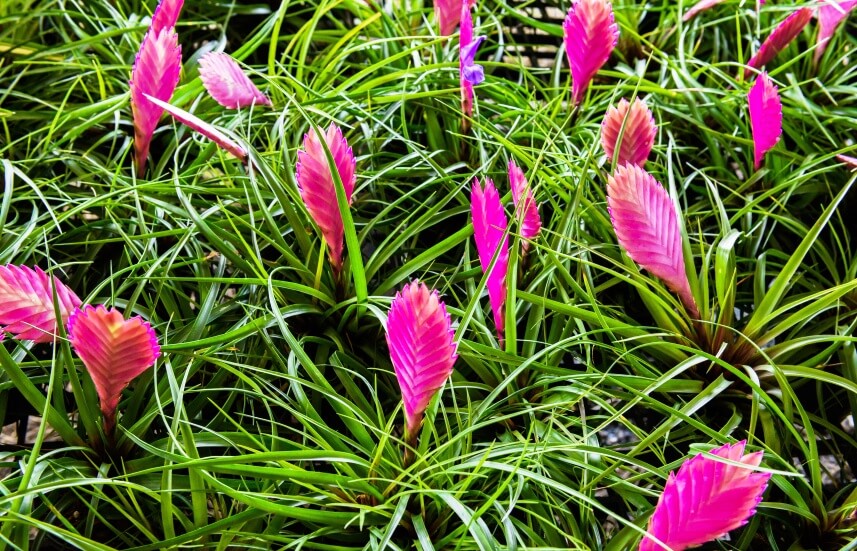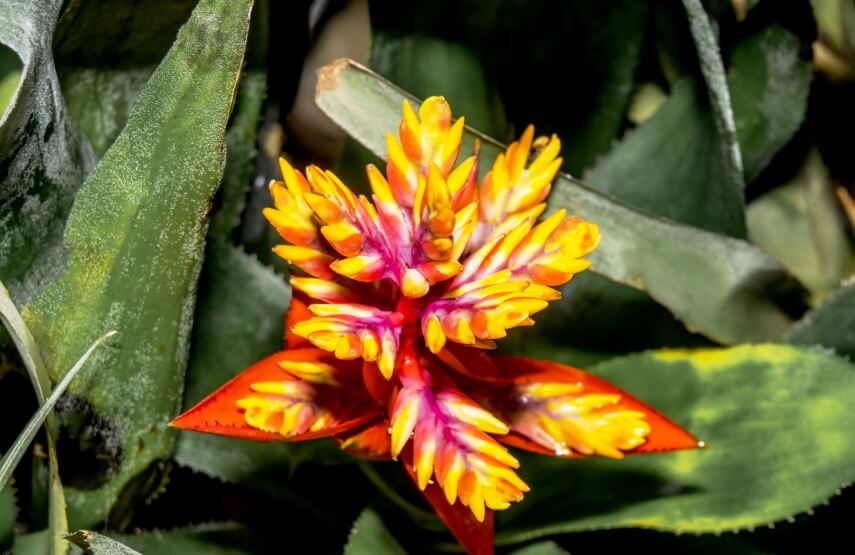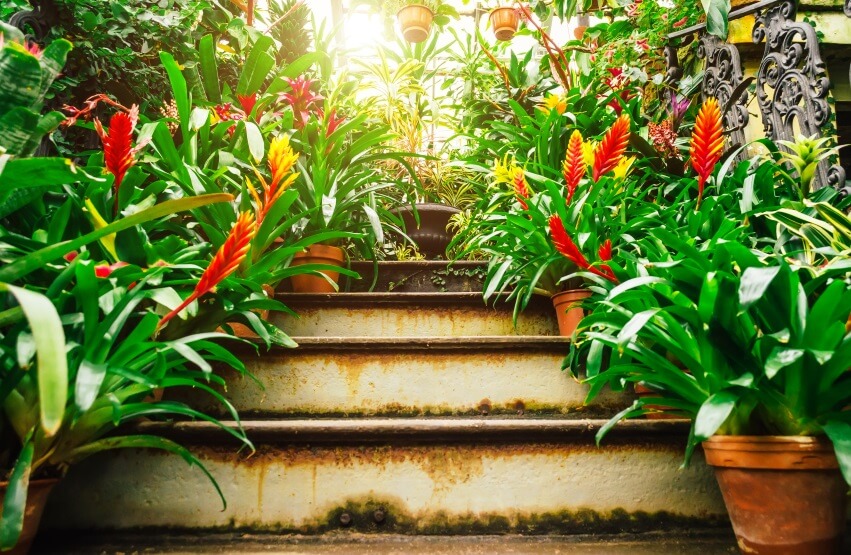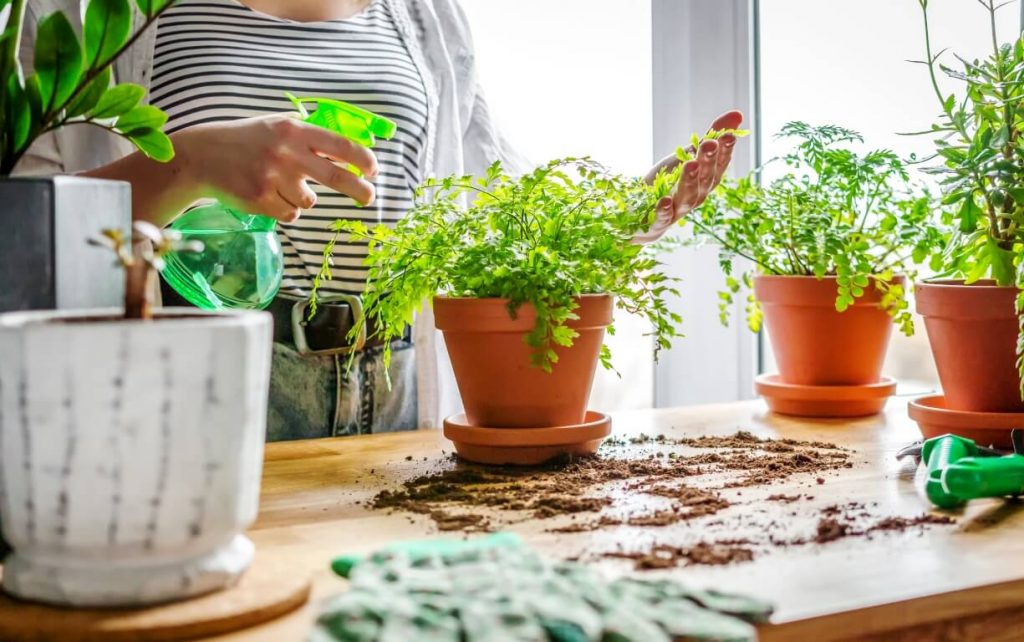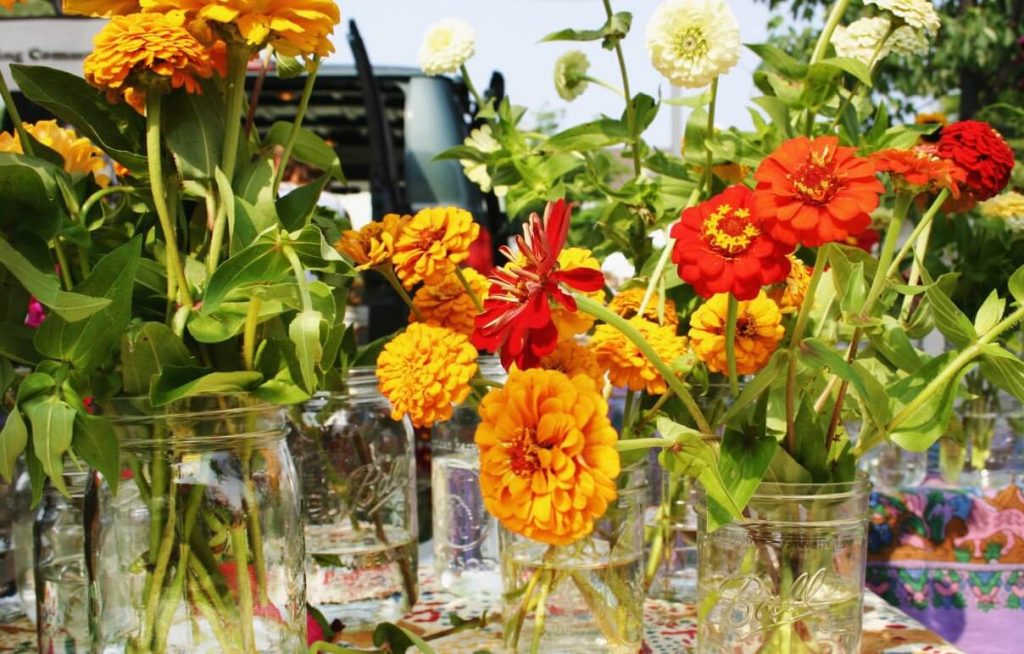One of the most common vriesea bromeliads planted indoors is the flaming sword plant or vriesea splendens. These bromeliads are native to South and Central America. They have exotic elegance, which adds life to any environment.
If you are interested in this topic, you can also read
<<Persain Violet Care >> and <<Guzmania Lingulata Care>> articles.
Vriesea Splendens Overview
| Family | Bromeliaceae |
| Origin | Trinidad, eastern Venezuela, and the Guianas |
| Names | Vriesea, Flaming sword |
| Genus | Vriesea |
| Type | Epiphyte |
| Cultivars | Vriesea Fireworks, V.Vigeri V.Wiotiana, V.Poelmanii, V.Cardinalis, V.Intermedia, and V.Mariae |
| Dimensions | Height: 2.50 to 3.00 feet / Spread: 1.50 to 2.00 feet |
| Toxicity | Non-toxic |
| USDA Hardiness Zones | 10 to 12 |
| Bloom Time | Seasonal bloomer |
| Foliage | Evergreen |
| Propagation method | Seeds & offsets |
About Flaming Sword
The flaming sword plant has a crimson sword-like flower head and lovely mottled leaves, which form a compact vase in the middle. Mature vriesea splendens can grow 20 in/50 cm tall and 24 in/60 cm wide.
Flaming sword bromeliad requires bright sunshine, warm temperatures, and moderate to high humidity levels to thrive. It is not as simple to grow as some other bromeliads. If everything goes according to plan, a 3 to 4 years old plant will reward you flattened flower spike that is often brilliant red and has little yellow blooms coming from the bracts [1].
The spike lasts for a few weeks, after which the plant gradually declines while sprouting one or more offsets. To grow a new plant from the pup, wait until the parent plant is almost dead.
Vriesea Splendens Cultivars / Varieties
Vriesea splendens comes in a wide range of varieties with different foliage hues and flower spike colors.
Vriesea ‘Fireworks’ is a cultivar created from the ‘Velva Wurthmann’ and ‘Rosa Morena’ variants of the flaming sword plant. The outcome is a stunning plant with glossy, brilliant green foliage. This cultivar has several branching, slender, flat offshoots with deep crimson flower spike that rises from the middle of the plant [2].
There are 714 cultivars, and 171 species of Vrieseas recognized in the Florida Council of Bromeliad Societies Photo Index of Bromeliads [3]. Any bromeliad fan is likely to be able to find a special plant that satisfies their needs for size, light, and color preferences for both the leaf and flower spike.
Dr. Gilbert Samyn’s article at the Australian Bromeliad Conference reviews the history of Vrieseas cultivars. Dr. Samyn attributes much of the development of Vriesea hybrids to Belgian botanists and hobbyists. He claims that between 1879 and 1920 was the period when interest in hybrid plant cultivation peaked. Following that, curiosity about unusual plants substantially dropped [4].
Most people prefer types that are uniform and simple to keep. That is why some hybrids have disappeared, some have been reproduced recently, and some have been continuously cultivated. The following six cultivars are widely utilized today: V.’Mariae,’ V. ‘Wiotiana,’ V. ‘Cardinalis,’ V. ‘Intermedia,’ V. ‘Poelmanii,’ and V. ‘Vigeri’. Recently, interest in unusual bromeliads has grown, and hybridization for Vrieseas is once more popular.
Finding certain species and cultivars that support particular desirable characteristics is a benefit of studying bromeliad hybridization. The ability of the plant to survive in colder climates is one desired quality in the bromeliad community. According to studies, two Vriesea species and cultivars are more cold-resistant than other Vriesea varieties. The top four cold-resistant Vrieseas were found to be: Vrieseas’ Marjan’, ‘Poelmanni’, ‘hieroglyphica’, and ‘zamorensis’ [2].
Vriesea Splendens care
Since most vrieseas are epiphytes—plants that grow on trees rather than in soil—they require a somewhat different type of maintenance than other indoor potted plants. But as you get to know these charismatic plants, you’ll immediately see why both casual indoor gardeners and ardent bromeliad collectors adore them.
Now, this Section will discuss each component of vriesea care in more detail [1,5]:
Light
Flaming Sword Bromeliads don’t need a lot of light. They may survive contentedly in an east or west window, but if they get a few hours of direct sunlight daily, their growth and flowering will be more noticeable. These plants would generally benefit from bright indirect light year-round with some direct sun in the winter.
Temperature
Flaming Sword plants thrive in typical home temperatures. The preferred range of temperatures is between 70 and 80 °F (21-27 °C). They are unable to withstand extreme heat or cold.
Fertilizer
An all-purpose indoor plant fertilizer prepared at half the normal strength can be used to feed your vriesea splendens plant once a month.
Water
Keep the soil slightly wet at all times, and replenish the water in the reservoir every two weeks. Mist the plant once a week, and keep the room humid.
Humidity
Although high humidity is not necessary for this plant, vriesea splendens will be happier and healthier under higher humidity. To prevent your bromeliad from being sick, make sure not to let the cup in the center of the leaves become completely dry. To help raise humidity levels, mist this plant once or twice a week, but be careful not to overwater it.
Soil
The materials used to create the flaming sword bromeliad growing media should be light, quick to dry, and aerated. Use pre-made bromeliad or orchid potting soil, or create your own by combining peat moss, coco coir, perlite, and pine bark.
Repotting
After two years, repot young plants, and keep adult plants’ pot sizes to 6 in./15 cm.
Life Span
The flaming sword can survive for three to four years on average.
Selection
There are numerous identified variants with different leaf variegation and flowering spike color. Purchase plants that are either just starting to produce a flowering spike or have not yet bloomed.
Display tips
The striking foliage colors make it a compelling focal point even when the plant is not in flower. Due to its width, it looks best when displayed on a high platform, surrounded by smaller ferns or other low-light plants.
Propagating flaming Sword Bromeliad
Vriesea splendens is a tropical plant that must have both bright sunshine and moisture to grow. This bromeliad typically yields one healthy pup following flowering. Once they have grown to half the size of the parent plant, these pups, which are identical duplicates of the mother plant, can be removed and replanted.
Once the plant has matured enough, you can reproduce it by planting an offset. Allow it to develop until it reaches a minimum height of 8 in. You can now separate it from the parent plant and replant it in a different pot.
You can also choose to propagate flaming sword bromeliad from seeds; however, like growing other bromeliads, this method requires a lot of time. Due to its speed, simplicity, and superior results, most gardeners prefer the offset approach.
Vriesea splendens Potential Problems [6]
- Brown leaf tips: The first potential factor is dry air, which misting will alleviate. It’s also possible that the water in the plant’s vase isn’t full.
- Brown leaf patches: The most likely reason could be extensive direct sunlight. Put the plant somewhere that gets less direct sunlight.
- The plant dies: As previously explained, this plant dies naturally after flowering. Overwatering and root rot may be the problems if the plant has not yet bloomed.
- Pests: Scale and mealy bugs can cause some issues.

